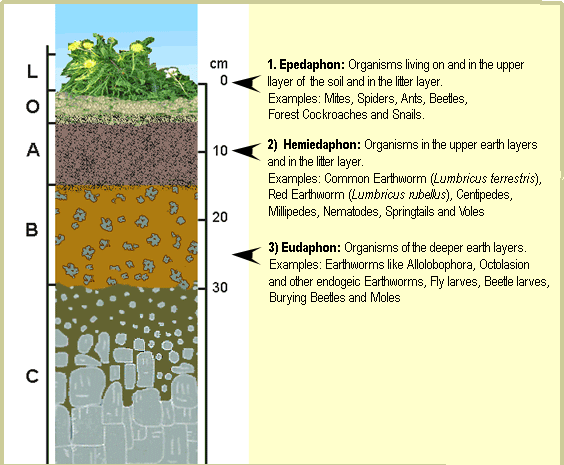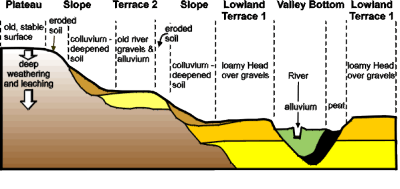Once the rock has been broken down, a process called
erosion transports the bits of rock and minerals away. No rock on Earths surface is hard enough to resist weathering. Together, the processes of weathering and erosion carved the
Grand Canyon, in the U.S. state of Arizona. This massive canyon is 446 kilometers (277 miles) long, as much as 29 kilometers (18 miles) wide, and 1.6 kilometers (1 mile) deep.
Weathering and erosion constantly change the Earth. Weathering wears away exposed surfaces over time. It smoothes sharp, rough areas on rocks. Weathering also helps create
soil as tiny bits of weathered rock mix with plant and animal
remains.
Weathering can be a mechanical or a chemical process. Often, these two types of weathering work together.
Mechanical Weathering
Mechanical weathering, also called
physical weathering, causes rocks to crumble. Water
seeps into cracks and
crevices in rock. If the temperature drops low enough, the water will freeze. When water freezes, it
expands. The ice then works as a
wedge. It slowly widens the cracks and splits the rock. When ice melts, water performs the act of erosion by carrying away the tiny rock fragments lost in the split.
Mechanical weathering also occurs as the rock heats up and cools down. The changes in temperature cause the rock to expand and
contract. As this happens over and over again, the rock weakens. Over time, it crumbles.
Another type of mechanical weathering occurs when
clay or other materials near hard rock absorb water. The clay swells with the water, breaking apart the surrounding rock.
Salt also works to weather rock. Saltwater sometimes gets into the cracks and
pores of rock. If the saltwater
evaporates,
salt crystals are left behind. As the crystals grow, they put pressure on the rock, slowly breaking it apart.
Plants and animals are agents of mechanical weathering. The seed of a tree may sprout in soil that has collected in a cracked rock. As the roots grow, they widen the cracks, eventually breaking the rock into pieces. Over time, trees can break apart even large rocks. Even small plants, such asmosses, can enlarge tiny cracks as they grow.
Animals that tunnel underground, such as moles and prairie dogs, also work to break apart rock and soil. Other animals dig and trample rock aboveground, causing rock to slowly crumble.
Chemical Weathering
Chemical weathering changes the materials that make up rocks and soil. Sometimes, carbon dioxide from the air or soil combines with water. This produces a weak acid, calledcarbonic acid, that can dissolve rock.
Carbonic acid is especially effective at dissolving limestone. When the carbonic acid seeps through limestone underground, it can open up huge cracks or hollow out vast networks of caves. Carlsbad Caverns National Park, in the U.S. state of New Mexico, includes more than 110 limestone caves. The largest is called the Big Room. At about 1,200 meters (4,000 feet) long and 190 meters (625 feet) wide, it is the size of six football fields.
Sometimes, chemical weathering dissolves large regions of limestone or other rock on the surface of the Earth to form a landscape called karst. In these dramatic areas, the surface rock is pockmarked with holes, sinkholes, and caves. One of the worlds most spectacular examples of karst is Shilin, or the Stone Forest, near Kunming, China. Hundreds of slender, sharp towers of limestone rise from the landscape.
Another type of chemical weathering works on rocks that contain iron. These rocks rust in a process called oxidation. As the rust expands, it weakens the rock and helps break it apart.
Weathering and People
Weathering is a natural process, but human activities can speed it up. For example, certain kinds of air pollutionincrease the rate of weathering. Burning coal, natural gas, and oil releases chemicals such as nitrogen oxide and sulfur dioxide into the atmosphere. When these chemicals combine with sunlight and moisture, they change into acids. They then fall back to Earth as acid rain.
Acid rain rapidly weathers limestone, marble, and other kinds of stone. The effects of acid rain can be seen on gravestones. Names and other inscriptions can be impossible to read.
Acid rain has also damaged many historic buildings andmonuments. At 71 meters (233 feet) tall, the Leshan Giant Buddha at Mount Emei in China is the worlds largest statue of the Buddha. It was carved 1,300 years ago and sat unharmed for centuries. But in recent years, acid rain has turned its nose black and made some of its hair crumble and fall.



